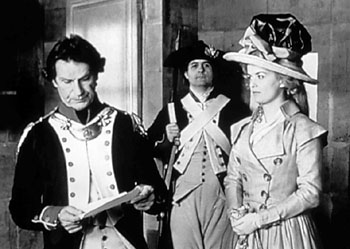![[Metroactive Movies]](/movies/gifs/movies468.gif)
[ Movies Index | Show Times | Silicon Valley | Metroactive Home | Archives ]
French Fried
In 1792, a Scottish aristocrat survives the Reign of Terror in Eric Rohmer's 'The Lady and the Duke'
By Richard von Busack
IN PARIS, visitors to the Conciergerie--the medieval fortress and army barracks on the Seine--can see the cell where Marie Antoinette was supposedly imprisoned shortly before her appointment with the National Razor. To interfere with any natural sympathies you might have about the guillotined queen, the management has installed a wax statue of Her Majesty brooding over some needlework. This sight thickened the already thick callous I've grown against feeling the plight of aristos taken to the scaffold (especially when so few have tears to spare for the nameless thousands killed by the French monarchy over the centuries). However, the new Eric Rohmer film, The Lady and the Duke, awakened in me more sympathy for the ruling class under siege than had been roused before--though maybe I had experienced a few restless twitches during the better film versions of A Tale of Two Cities and The Scarlet Pimpernel.
This gripping tale in five acts is based on a memoir by Lady Grace Elliott (Lucy Russell), a Scottish divorcée who briefly became a mistress of Philippe, the Duke of Orléans (Jean-Claude Dreyfus), a Republican sympathizer who notoriously voted for the execution of his cousin, Louis XVI. Elliott's friendship with this left-winger is strained by time, betrayal and illness. Although she's a charming woman without many prejudices, Grace, like almost every royalist, has a false conviction in the essential order of things. Through Rohmer's customarily intelligent script, we see how her faith in the old regime is exposed to the beginnings of the modern world--and how, despite the threat of death, she holds on to the old-fashioned ideas that a gentleman's private correspondence shouldn't be opened and a lady's chamber ought not to be invaded by the secret police.
Rohmer has achieved his simulation of the past without the usual ostentatious trappings of historical drama, shooting on digital Beta and then transferring it to 35 mm stock. The film's sensuously composed backdrops, derived from engravings of the time and painted by Jean-Baptiste Marot, make suspension of disbelief a pleasure. Rohmer avoids calculated melodrama: in the most shocking scene, Grace sees a mob carrying the head of a friend on a pike. Like the one on the statue of Marie Antoinette, the head is plainly wax. Only one thing can animate such a tableau, and that is acting--and the acting here is faultless and unsentimental.
Sometimes the film reveals a slight staginess, as in some chitchat about the duke's friend Laclos and his scandalous novel (yeah, we get it, Dangerous Liaisons). Still, without anachronism, Rohmer has interjected the 20th century into the French Revolution. In this luminous distant mirror, we see our own sad, familiar experiences with tin-pot militiamen, hostile bureaucrats, informers and all the erstwhile freedom fighters who seek blood, not justice.
[ Silicon Valley | Metroactive Home | Archives ]
Copyright © Metro Publishing Inc. Metroactive is affiliated with the Boulevards Network.
For more information about the San Jose/Silicon Valley area, visit sanjose.com.
![]()

Do You Have A Permit For That Hat?: Grace Elliott (Lucy Russell) tries to survive the French Revolution in 'The Lady and the Duke.'
The Lady and the Duke (PG-13; 129 min.), directed and written by Eric Rohmer, based on the memoir by Grace Elliott, photographed by Diane Baratier and starring Lucy Russell and Jean-Claude Dreyfus, opens Friday at the Towne Theater in San Jose.
Send a letter to the editor about this story
.
From the May 23-29, 2002 issue of Metro, Silicon Valley's Weekly Newspaper.